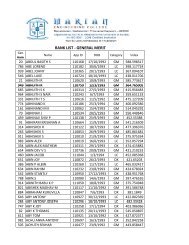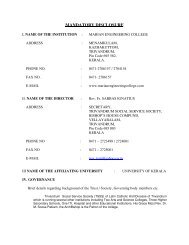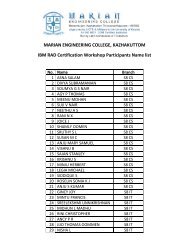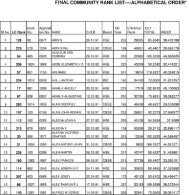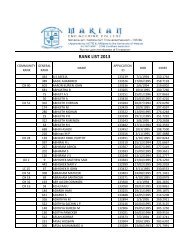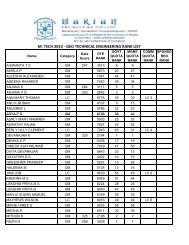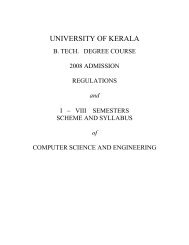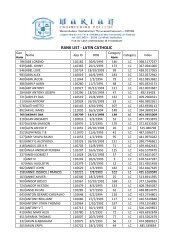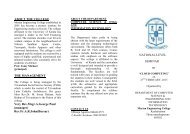UNIVERSITY OF KERALA - College of Engineering, Trivandrum
UNIVERSITY OF KERALA - College of Engineering, Trivandrum
UNIVERSITY OF KERALA - College of Engineering, Trivandrum
Create successful ePaper yourself
Turn your PDF publications into a flip-book with our unique Google optimized e-Paper software.
08.606.8 Elective II HYDROLOGY AND WATER RESOURCES<br />
L T P/D Cr<br />
3 1 0 4<br />
Module I<br />
Basic concept <strong>of</strong> Hydrology and Hydrology cycle- Graphical representation <strong>of</strong> rainfall data- Analysis <strong>of</strong> rain fall<br />
data- Correlation <strong>of</strong> rainfall records- intensity duration and frequency relation ship-DAD curves-Design storm<br />
and PMP –Consistency <strong>of</strong> rainfall data- double mass analysis. Water losses-interception-evaporation-method <strong>of</strong><br />
estimation-Evapotranspiration- method <strong>of</strong> estimation-infiltration-method <strong>of</strong> estimation.<br />
Module II<br />
Run<strong>of</strong>f – stream network-ordering, characteristics – estimation <strong>of</strong> run<strong>of</strong>f- Rational method SCS method - Unit<br />
hydrograph analysis(Sherman&Bernard distribution graph)- S hydrograph-unit hydrograph from Complex<br />
storms- synthetic unit hydrograph- instantaneous unit hydrograph-Linear reservoir model.<br />
Stream gauging- Area velocity method- current meter- rating <strong>of</strong> current meter- Stage discharge rating curve-<br />
Extension <strong>of</strong> stage discharge rating curve- Adjustment <strong>of</strong> stage discharge rating curve- selection <strong>of</strong> site for a<br />
stream gauging station.<br />
Module III<br />
Floods and their estimation- definition, causes, design flood, chance flood, estimation <strong>of</strong> design flood, and flood<br />
frequency- empirical formula such as Dicken’s, Ryves- statistical method – California method- Gumbel’s<br />
method<br />
Flood routing-Hydraulic and hydrologic routing (concepts only)-reservoir routing- I-S-D method -channel<br />
routing- Muskingum method.<br />
Flood control methods- Flood control reservoirs- retarding basins – construction <strong>of</strong> levees- channel<br />
improvement- soil conservation method- flood forecasting and warning.<br />
Reference:<br />
1. E. Subrahmanya <strong>Engineering</strong> Hydrology’’,Tata McGraw-Hill publishing Company Ltd,New Delhi.<br />
2. H. M. Reghunath,’’Hydrology’’,Wiley Eastern Ltd,New Delhi.<br />
3. Hydrology & Water resources engineering, S. K. Garg, Khanna Pubblishers<br />
4. Ven. Te Chow,’’Hand book <strong>of</strong> applied Hydrology’’, Tata Mc Graw Hill<br />
5. Linsley R. K., Kohier, M. A. and Paullus, J. L., “ Applied Hydrology’’, Mc Graw Hill.<br />
6. B. C. Punmia,’’Irrigation and Power <strong>Engineering</strong>’’, Laxmi publications (P) Ltd<br />
Question Paper:<br />
Duration: 3 hours<br />
The question paper consists <strong>of</strong> Part A and Part B.<br />
Part A is for 40 marks. There will be 8 compulsory short answer questions <strong>of</strong> 5 marks each covering entire<br />
syllabus.<br />
Part B is for 60 marks. There will be two questions from each module. The candidate has to answer one<br />
question <strong>of</strong> 20 marks from each module.<br />
Note: No charts, tables, codes are permitted in the Examination hall .If necessary the same shall begiven along<br />
with the question paper by the question paper setter<br />
66



